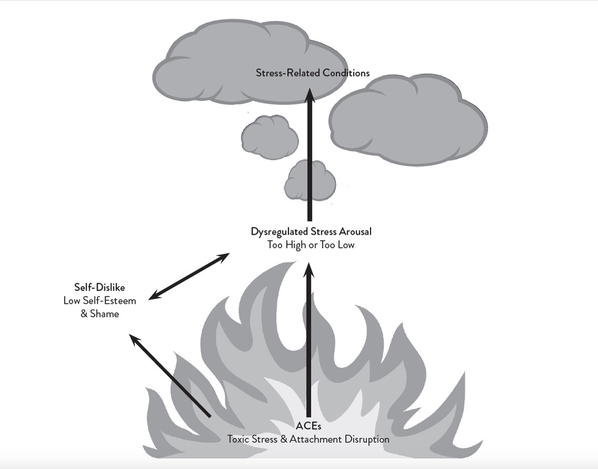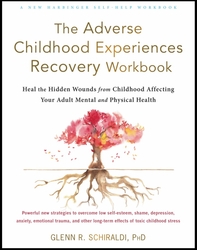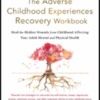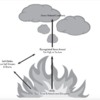Since 1998, research has consistently demonstrated that Adverse Childhood Experiences (ACEs) predict adult health problems ranging from headaches and obesity to depression, anxiety, autoimmune disorders, heart disease, cancer, and sleep disorders. But how do events that occurred way back in childhood continue to affect our health so many years later? Let’s see how this happens, for gaining an understanding of the mechanisms will later point us to ways to break the ACEs/adult health link.
 Source: Schiraldi, G. R. 2021. The Adverse Childhood Experiences Recovery Workbook. Oakland, CA: New Harbinger. ©2021 Glenn R. Schiraldi, Ph.D. Not to be copied.
Source: Schiraldi, G. R. 2021. The Adverse Childhood Experiences Recovery Workbook. Oakland, CA: New Harbinger. ©2021 Glenn R. Schiraldi, Ph.D. Not to be copied.
As the diagram above shows, dysregulated stress is central to the ACEs/health outcomes relationship. Toxic stress in childhood can imprint and change the brain, biology, and sense of self in ways that affect adult well-being throughout life, if not addressed. This is why the originator of ACEs research, Dr. Vincent Felitti, stated that we err to treat the smoke (stress-related conditions) without treating the flame (the underlying wounds from childhood that cause and maintain dysregulated stress). Dysregulated stress disrupts all systems of the body, including these.
Neurological Systems
Overwhelming stress in childhood, particularly during the brain’s tremendous growth spurt in the first three years of life, influences brain development in ways that keep the brain on high alert. During this growth spurt, traumatic experiences register not in the not-yet-developed (verbal/thinking) left brain, which will later be able to recall memories consciously with words and reason, but in the relatively well-developed right brain. The right brain, with its strong connections to the emotional, and survival regions of the brain, oversees non-verbal, non-conscious processing of memories. It imprints childhood memories, which are experienced as images, sensations, visceral states (e.g., sick to the stomach; constriction of the throat; survival tendencies, such as tensing muscles and preparing to run away) and a strong feeling tone (a felt sense of nameless dread; a sense of inadequacy, depression, shame, anxiety, and so forth). Even after the left brain more fully develops, the right brain will remain dominant for emotional processing of traumatic memories because the left brain goes off-line during overwhelming stress. It’s as though the brain says, “This is an emergency. There is no time to speak or reason with the threat. Right brain, take over.” If unaddressed, the patterns of danger and high alert that are imprinted in the right brain tend to persist, beneath the level of conscious awareness, over the lifetime.
Dysregulated Stress Hormones
Overwhelming stress can cause over- or under-secretion of stress hormones. (Under-secretion can result from chronic stress that exhausts the supply of stress hormones.) Cortisol is a major stress hormone that helps the body mobilize for fight or flight. It is usually helpful in the short term. For example, cortisol converts protein to sugar to provide fuel for the stress response. Dysregulated cortisol, however, is linked to:
- Obesity
- Elevated blood sugar and diabetes
- Inflammation—a common culprit in a wide array of disorders
- Immune dysfunction (Too much cortisol suppresses immunity, leaving us vulnerable to colds, flu, and other infections. Too little cortisol allows the immune system to become over-reactive, putting us at risk for autoimmune disorders. Toxic stress in the early years can impair the immune system’s ability to distinguish friend from foe.)
- Impaired brain and lung development resulting from the conversion of protein to sugar
- Disrupted sleep and mood
- Harmful changes in epigenomes and telomeres. The epigenome sits alongside DNA strands and determines gene expression, and therefore how the brain develops. Cortisol also shortens telomeres, the protective “cap” of the chromosome, which also disrupts proper brain development.
What Have We Learned So Far?
Toxic childhood stress can profoundly and continuously affect the adult’s brain and biology. Dysregulated stress is central to the ACEs/health outcome relationship. Reducing the suffering of adults affected by the wounds from childhood adversity starts with regulating dysregulated stress—meaning we bring stress arousal levels within tolerable limits—neither too high nor too low. This allows the brain and body to restore physical health. Regulating stress also allows the brain regions that were pushed off-line by overwhelming stress come back on line— including the verbal, logical left brain and the regions that give us an integrated sense of self. This prepares the adult to process, settle, and rewire the inner wounds—the troubling memories that were imprinted in the first eighteen years of life.
This blog has mainly addressed how dysregulated stress from ACEs changes our brain and biology. Our next blog will explore how ACEs change our psychology in ways that maintain dysregulated stress. Ultimately, this understanding will help us to apply the principles and skills that facilitate healing, well-being, and optimal functioning.
Notes
- Reference. Schiraldi, G. R. (2021). The Adverse Childhood Experiences Recovery Workbook. Oakland, CA, New Harbinger.
- This article first appeared in Psychology Today blog, October 5, 2021.
- Title Photo: Andrea Piacquandio/Pexels
About the Author
Glenn R. Schiraldi, PhD, has served on the stress management faculties at The Pentagon, the International Critical Incident Stress Foundation, and the University of Maryland, where he received the Outstanding Teacher Award in addition to other teaching/service awards. His fourteen books on stress-related topics have been translated into seventeen languages, and include The Adverse Childhood Experiences Recovery Workbook, The Resilience Workbook, The Post-Traumatic Stress Disorder Sourcebook, and The Self-Esteem Workbook. The founder of Resilience Training International (www.ResilienceFirst.com), he has trained laypersons, emergency responders, and clinicians around the world on various aspects of stress, trauma, and resilience.






Comments (4)